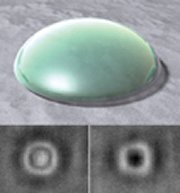A new type of sensor that uses tiny optical lenses may someday detect the first signs of disease or chemical contamination in blood or other liquids.

Each microscopic lens, less than half the diameter of a red blood cell, undergoes a change in optical properties when it encounters even a small amount of specific biomolecules or chemical compounds.
Chemist L. Andrew Lyon of the Georgia Institute of Technology in Atlanta and his colleagues made the lenses from spheres of hydrogel, a water-absorbent mesh of polymer molecules. By chemical means, the scientists wove into the outer layers of the mesh molecular complexes designed to bind to certain molecules.
Adhered to glass, each microsphere flattens into a hemispherical lens with a specific focal length. When fluid flows over the microspheres, the molecular complexes partially detach from the lens and snag target molecules. That process disrupts the hydrogel’s surface, and water enters and swells the lens. The expansion alters the lens’ focal length and diminishes transmitted light, Lyon says.
Because these changes typically occur within minutes, the microlenses may someday be used for on-the-spot diagnoses of infections or other conditions currently detected by time-consuming lab tests.
The lens findings appear in the Feb. 20 Angewandte Chemie.





